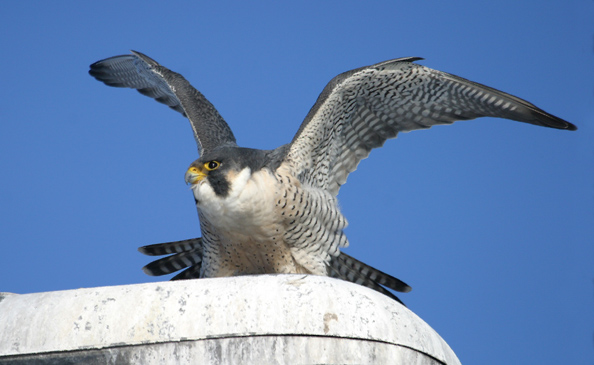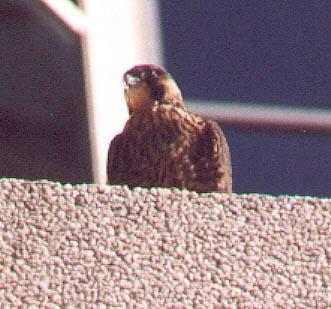|

Description: 15-21" (38-53 cm). W. 3' 4" (1 m). A large robust falcon with a black hood and wide black "mustaches."
Adults slate-gray above and pale below, with fine black bars and spots. Young birds brown or brownish slate above, heavily
streaked below.
Habitat Open country, especially along rivers; also near lakes, along coasts, and in cities. Migrates chiefly along coasts.
Nesting 2-4 cream or buff eggs, spotted with reddish brown, placed in a scrape with little lining on a cliff or building
ledge or in an abandoned bird's nest.
Range Breeds from Alaska and Canadian Arctic south locally through mountainous West, and sparingly in East. Winters coastally,
north to British Columbia and Massachusetts. Also in southern South America and Old World.
Voice Rasping kack-kack-kack-kack, usually heard at nest; otherwise generally silent.
|

|
| Baby Falcon |
Discussion: Following an alarming decline during the 1950s and 1960s, this spectacular falcon, also called the "Duck
Hawk," is on the increase again, now that pesticides that caused thinning of eggshells have been banned. After an intensive
program of rearing birds in captivity and releasing them in the wild (a process called "hacking"), this large falcon
is reclaiming nesting grounds from which it disappeared a few decades ago. A favorite nesting site nowadays is a tall building
or bridge in a city; these urban Peregrines subsist mainly on pigeons.
The Peregrine Falcon spent twenty years listed as an endangered species. Efforts to boost its numbers included captive
breeding programs and the protection of nest sites during the breeding season. Another important factor was the banning of
DDT, a pesticide that caused the birds to lay thin-shelled eggs that broke during incubation. Personally I was appalled to
learn that while Canada and the United States of America had banned the use of DDT the US continues to manufacture and sell
it to other countries. Most notably Mexico, where not only Peregrine Falcons can end up, during southern migration, but many
other smaller species and raptors. At one point the number of breeding pairs of Peregrine Falcons in all North America dropped
to a low of 324. Now it stands at more than 1,600.
How Can I Help? : Personally I can speak a bit to this from what I have learned. Over the last 2 years I have helped out
the Canadian Peregrine Foundation, albeit in a small but important way. Each year known sites are monitored faithfully by
foundation staff and volunteers, in anticipation of the day when that year's young attempt to fly. I've volunteered a few
times to help watch the young birds learning to fly. If they should come to the ground of a low roof top, they are captured
and released on the nest building or sometimes another nearby tall building. Its a small thing, but one that anyone with a
free afternoon can do to help. Currently in and around my city there are over 30 nesting sites. Simply report sightings. Last
year 2004 I was able to report that we observed a pair nesting. While the birds were known, the fact that they nested hadn't
been known previously. You can donate. be sure to check out any organization you are inclined to give to, some put more funds
directly to work then others. Just get out and enjoy the nature that's around you! Pass information onto friends...the old
quote "With knowledge comes power."
In general you and your friends and children can help get involved in local birding organizations and counts. One such
count in North America is called The Great Backyard Bird Count. A search of this and you will find a site, where each year
one weekend in February people all over Canada and The United States count all species and every individual they can and report
it to the site. This year the count has been expanded so you can count what's in the yard, a nearby park or lakeshore area,
anyplace at all. Get involved in these simple ways, if you wish and we can make an impact.
Back to Birding with Frank
|



